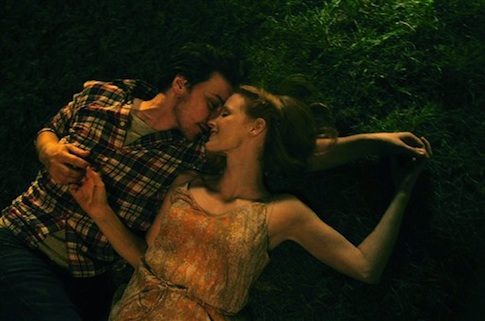It starts with a suicide attempt.
We see Eleanor (Jessica Chastain) cross a bridge in the New York, first on a bike, then on foot, then up and over the chain link fence. She survives, is met by her sister Alexis (Nina Arianda) in the hospital, and is taken home to Connecticut to recuperate. She wants space from her husband, Conor (James McAvoy). The reason is unclear at first, but we come to understand that their baby has died. She isn’t quite sure how to go on, aimlessly taking classes at her father’s (John Hurt) university, trying to reconnect with old friends whose problems seem as endless as they are meaningless, wandering through her memories of courtship.
And then we see it all again, from Conor’s perspective. He’s a struggling restaurateur, working with his best friend (Bill Hader) and living in the shadow of his successful father (Ciaran Hinds). His business and marriage collapsing, Conor is desperate to discover how to keep Eleanor from leaving him.
The Disappearance of Eleanor Rigby: Her/Him is essentially a double feature. Both halves of this double feature tell the same story. The first 100-minute movie is told from Eleanor’s point of view, and describes her need to "disappear," to find herself. The second 100-minute movie tells Conor’s side of the story, and shows the emptiness he feels at losing not only his child but also his wife.
Here we have a cinematic representation of subjectivity: the old Rashomon effect. While each movie focuses on the travails of Eleanor and Conor following her suicide attempt, scenes in which the couple is together appear in both. However, in the differing versions of these scenes, lines of dialogue are somewhat altered, objects are in slightly different positions, and the emphasis on who is "right" and who is "wrong" shifts. We come to realize we’re seeing each of these scenes from the point of view of the titular Him and Her. Cinematographically, Director Ned Benson emphasizes the differences between the two stories by using a balmy red tint for Her, a cool blue for Him, each color scheme corresponding to the title that accompanies each half of the double feature.
There are, it seems, four cuts of this picture: The Disappearance of Eleanor Rigby: Her; The Disappearance of Eleanor Rigby: Him; The Disappearance of Eleanor Rigby: Them; and The Disappearance of Eleanor Rigby: Her/Him. The final cut, the one I saw, is a rather audacious cinematic experiment, clocking in at 195 or so minutes and asking the audience to stick around for both perspectives in their entirety. It is something of an endurance test.
But, if you have three-plus hours to spare, you’ll find good company. McAvoy and Chastain are great, plumbing the emotional depths of their characters’ broken marriage.
However, it’s the supporting cast that really shines: Hurt and Hinds as fathers incapable of helping their children; Hader and Arianda walking on eggshells around the couple; and a great turn from Viola Davis as a college professor trying to snap Eleanor out of her funk.
